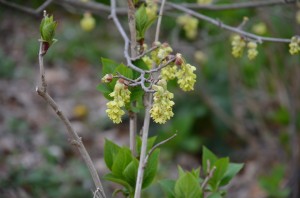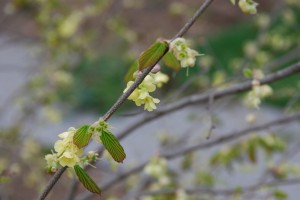Winterhazels (Corylopsis spp.), native to China and Japan, represent a group of winter flowering shrubs of varying heights and widths (USDA hardiness zones 5 to 8). Few U.S. gardeners know them. Their bright yellow colored flowers are larger and showier than witchhazels (Hamamelis spp.). Flowering begins as the witchhazels (they’re related) are finishing up in late February and March, many weeks before forsythias bloom.
The winterhazels are welcome additions to shrub borders or woodland spaces. There are eight or more species available from on-line nurseries. Spike winterhazel (C. spicata) and buttercup winterhazel (C. pauciflora) are low growing or spreading forms that fit well into urban and suburban gardens. The lemony yellow flowers have red-purple anthers and are slightly fragrant.
Spike winterhazel grows to 4-8 feet tall and to 6-10 feet wide. Individual flowers, only 3/8 inches long, comprise small drooping clusters (racemes to 2 inches long); clusters contain 6-12 flowers. After bloom, 4-inch long ovate to obovate leaves unfold colored bronze-purple and, within weeks, change to blue-green color. Tiny hairs on the leaf surface tend to collect dust over the summer, resulting in a blah yellowish-green fall color. Fruits are two-beaked capsules, each containing two small seeds.
Winterhazels prefer a compost-rich, well-drained, acidic soil in full sun to part shade. Winterhazels tolerate most garden soils except heavy clays. Plants favor shading from direct afternoon sun in southerly climate zones as well as shelter from high winds. Flower buds/flowers are susceptible to cold injury if winter temperatures are severe.
After flowering or by late spring, prune winterhazels as needed to hold them in check. At the same time feed with 10-10-10 or equivalent granular fertilizer. There are no serious insect or disease problems.



 Posted in
Posted in 
